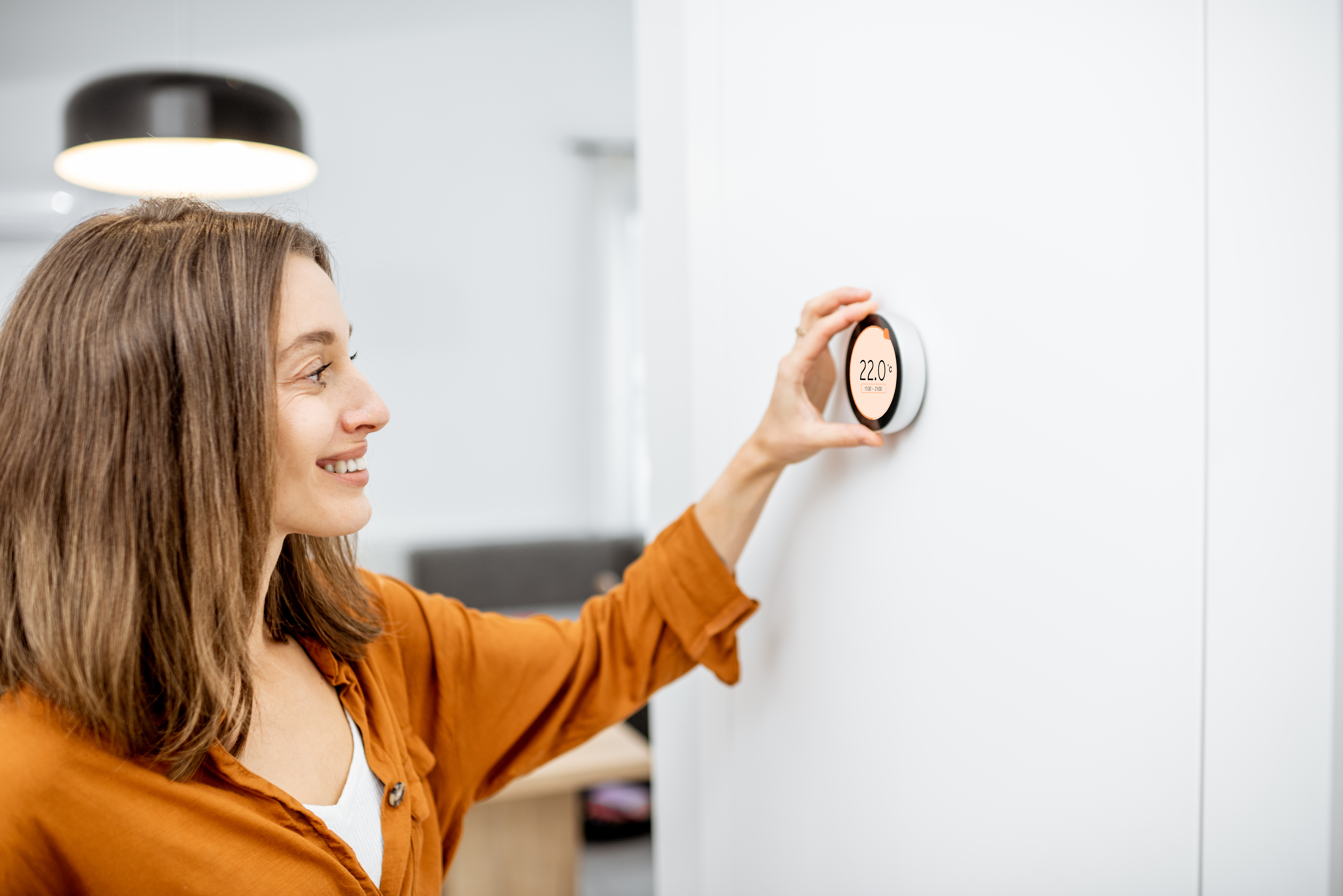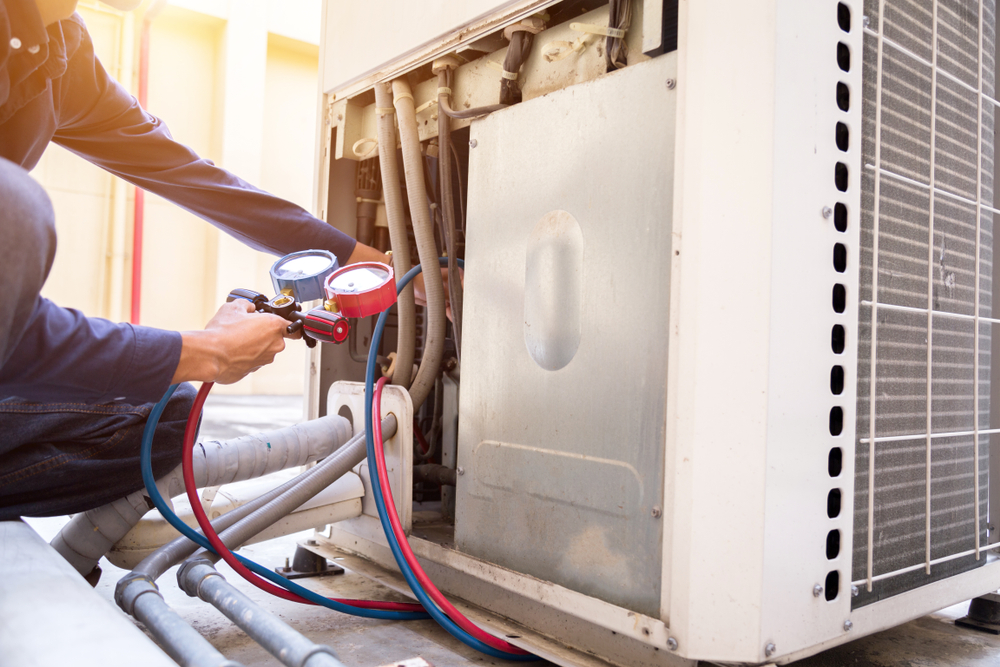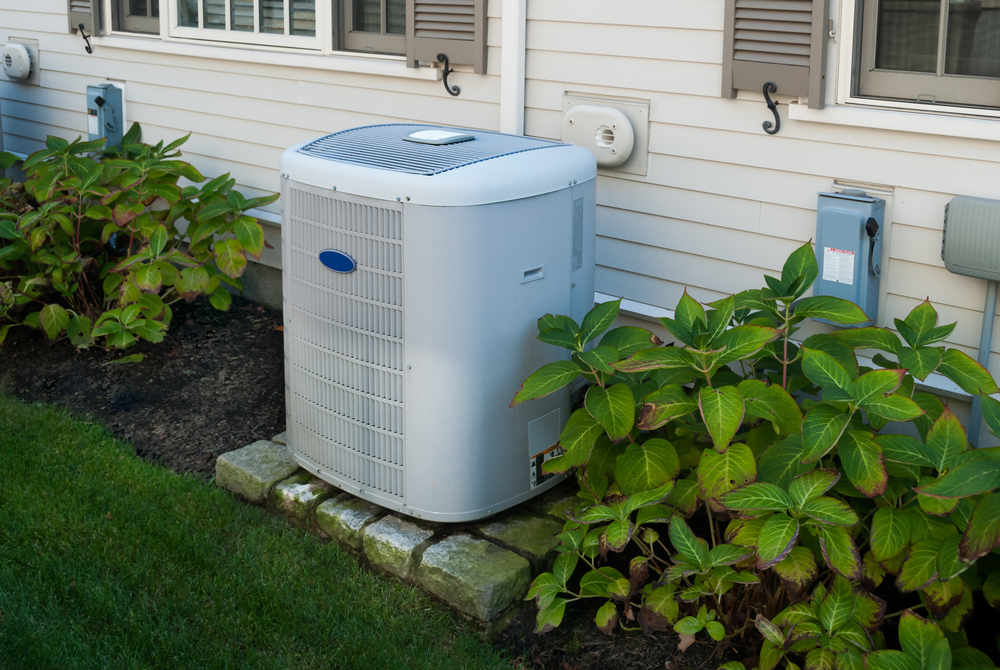What Is a House HVAC System?

There’s nothing better than walking into a cold home with the AC blasting in the middle of summer. Or, walking into a warm home when it just started to snow and temperatures have dropped below freezing. We spend a lot of our time inside our homes, so it’s ideal that they’re kept at the most comfortable temperatures.
The reason your home stays warm in the winter and cold in the summer is because of your HVAC system. What is an HVAC system in a house, you ask? HVAC stands for heating, ventilation, and air conditioning. It’s the system that heats and cools your home, controlled by a thermostat.
Having a high-quality, working house HVAC system is crucial, but understanding the different types and how they work can be difficult. In this post, we’ll be discussing the various types of HVAC systems, how much a house HVAC system costs, and more.
What Is an HVAC System in a Home and How Do They Work?
So, what is an HVAC system in a house? A house HVAC system controls the heating and cooling of the home. Your home’s HVAC system uses fresh air from the outdoors to supply air indoors, while removing moisture, smoke, odors, dust, bacteria, and more, to fill your home with high-quality air. It also provides temperature control and oxygen replenishment. Some homes are heated and cooled with boilers, heat pumps, or window air conditioners, but an HVAC system combines a furnace and a split-system air conditioner.
There are three main functions of a residential HVAC system: heating, ventilation, and air conditioning. The heating component is handled by a furnace or boiler. The ventilation component can either be natural or forced. The air conditioning component works to remove existing heat from the inside of the home.
An HVAC house system contains eight parts that contribute to these functions, including:
A Thermostat
The thermostat is how you regulate the heating and cooling components of an HVAC system. With a thermostat, you can control when the furnace and air conditioners come on. You can even install a programmable thermostat, which allows you to set a schedule for temperatures. For example, you can set the air conditioning to come on at a specific temperature at the same time every day.
A Furnace and Blower Motor
These are two main parts of a house HVAC system. The furnace pushes the heated or cooled air through the system with a blower motor. Incoming air is heated by a fuel source, which can either be natural gas, oil, or electricity. The blower motor will move the heated air throughout the ductwork, which will come through the supply registers. Then the cool air comes back in from the return registers.
A Heat exchanger
Once air is brought into the furnace, a heat exchanger will warm it. How the air is heated depends on the type of fuel source in your HVAC system. If your HVAC system is fueled by gas or oil, a burner will do the heating. If your HVAC system is powered by electricity, electric coils will heat the air. Once heated, the warm air will come back into your home through the supply registers.
An Evaporator Coil
Located on either the top or side of the furnace, an evaporator coil cools the air that moves through your home. Once the evaporator coil turns on, it uses the blow motor to distribute the cold air throughout your ductwork. The refrigerant will absorb the heat so that the cool air can move around freely.
A Condensing Unit
The condensing unit is the part of an HVAC system that you can see from outside the home. This component holds the refrigerant gas that is cooled by exchanging heat with the outside air. The refrigerant gas is turned into a liquid, which moves through the evaporator coil, cooling the air in your home.
Refrigerant Lines
Refrigerant lines are a crucial component of air conditioning. Made from either copper or aluminum, refrigerant lines carry the liquid from the outside condensing unit to the inside furnace.
Ductwork
The ductwork is responsible for distributing conditioned air throughout a home. Ductwork should be installed in the walls or ceilings, and you should avoid the attic, garage, or crawl space.
Return and Supply Registers
Registers cover ductwork openings and can be opened and closed to control airflow. It’s important to not block the registers with furniture or rugs so that the airflow doesn’t get disrupted.

Residential HVAC System Types
When installing a residential HVAC system, it’s good to know what your options are. Different residential HVAC system types will work for certain residences, so you want to know what is best for your individual needs. Below we’ll explain the different types of HVAC systems you can install in your home:
Split System
A split system has both an outdoor unit and an indoor unit. The outdoor unit holds the condenser and the compressor, while the indoor unit holds the evaporator coil and blower. The indoor unit is typically connected to a furnace. Most split systems have an outdoor unit, a refrigerant, an evaporator coil, a blower, ducts, and a thermostat.
A split system is one of the most popular types of HVAC systems for many reasons. The main advantage of using a split system is that it is one of the more affordable options. Additionally, very few modifications have to be made to a home’s existing ductwork when new components have to be installed. The disadvantage of using a split system is that it requires ductwork, and installing ductwork can be expensive.
Mini-Split (Ductless) System
A mini-split, or ductless, system has an outside air conditioner that only cools air or a heat pump that cools and heats the air. You can install this type of HVAC system directly into the space of your home that needs heating or cooling. A ductless system will usually have a heat pump, a fan coil, wires and tubing for the refrigerant, and a thermostat.
Ductless systems are ideal for a home where installing ductwork isn’t possible. You can install one outside unit, which can heat and cool up to four rooms. Ductless systems are also more energy and cost-efficient. The disadvantage of a ductless system is that it doesn’t have as many heating options as a regular split system, making them less suitable for colder environments.
Geothermal Heat Pump System
A geothermal heat pump system uses the temperatures of the earth to assist with heating and cooling. With geothermal heating, temperature-conducting fluid is moved through pipes installed underneath or near your home. The ground temperature is moderate all year long, which helps to remove heat in the summer and collect heat in the winter.
Geothermal heat pump systems are more energy and cost-efficient than some other types of heating. However, the drawback is that it can be up to five times more expensive than other systems.
Packaged System
A packaged system contains the compressor, condenser, and evaporator together in one unit. A packaged system is always installed inside a home. A packaged HVAC system will usually include the air conditioner and heat pump with an evaporator or fan coil and a thermostat.
Packaged systems are beneficial because they don’t generate much noise inside your home. But a packaged system should only be used when installing a split system isn’t possible. A packaged system doesn’t have as many options as a split or ductless system and is traditionally less efficient.
How Are Home HVAC Systems Different Than Typical Air & Heating Systems?

We've answered, “What is an HVAC system in a house?” but now you’re probably wondering, “How is a home HVAC system different from a typical air and heating system?” We’ll get into it below.
Air conditioning is just one aspect of an HVAC system. An HVAC system also handles the heating and cooling of air, and provides ventilation for moisture to escape. An HVAC unit consists of a furnace, an air conditioning unit, and vents to release moisture. This is very different from a traditional air and heating system. An air conditioning unit cools the air in your home. An HVAC unit does that as well, but it also heats the air.
Commercial vs. House HVAC Systems
It’s important to note the difference between a commercial and house HVAC system. Some of the key differences include:
- Size: A house HVAC system is much smaller than a commercial system, as the latter is used to heat or cool a much bigger area.
- Placement: A house HVAC system is located in the backyard or side of a house while a commercial HVAC system is typically located in a swamp cooler or roof.
- Complexity: The structure of a commercial HVAC system is more complex than one used for a house.
- Drainage: A commercial system has multiple pipes for drainage while a house system in a single pan.
- Mechanism: The manufacturing of a commercial HVAC system is modular while a house system is produced as a standalone unit.
- Equipment: A commercial HVAC system requires much more equipment to heat and cool than a house system needs.
- Maintenance cost: It’s more expensive to maintain a commercial system than a house system due to its size and complexity.
How Much Is an HVAC System for a House?
When it comes to installing a house HVAC system, costs can vary significantly depending on many factors, such as the make, model, and size of your home. Some other factors that affect cost include:
- Location
- Home size and construction
- Ductwork
- Project difficulty
You can expect to pay about $25 to $60 per square foot, according to HomeAdvisor, which reveals the average HVAC replacement costs about $5,000 to $10,000 plus installation. The installation for a brand-new HVAC system can range from $1,500 to $12,500, with additional labor costs.
If the cost of installing an HVAC system is a potential setback for you, consider PACE financing. PACE financing can help you afford eco-friendly upgrades for your home, like installing an HVAC economizer. It is not a loan, but rather a property assessment, which means the funding is tied to your home (not you), and you make payments with your property taxes. With PACE financing, you can install an energy-efficient HVAC system with no upfront costs or payments for up to a year or more.
In addition to saving on the upfront cost, you may even be eligible to receive an HVAC tax credit, which is an incentive that allows homeowners to lower their tax liability by making energy-efficient home upgrades.
Is a House HVAC System a Worthwhile Investment?
Installing a house HVAC system isn’t just better for the environment, it’s good for your bank account, too. Upgrading to a newer, more efficient HVAC model can save you money on your energy bills while keeping your home at comfortable temperatures all year long.
If you’re not sure when to replace your HVAC system, you should look at the costs of your energy bills and whether you’ve had your current heating or air conditioning system for over 10 years. Having an outdated HVAC system may end up costing you more in the long run than a newer, more efficient model.
Install a New HVAC System & See the Difference
An HVAC system is how your home stays at pleasant temperatures throughout the year. Installing a new HVAC system that’s more energy and cost-efficient can keep your home and your wallet comfortable all year long. If your heating or cooling system is on its last legs, upgrade to a new HVAC system today. Don’t stress about your household budget — apply for PACE financing to help you get started. You’ll see the difference in your home’s temperature in no time.




